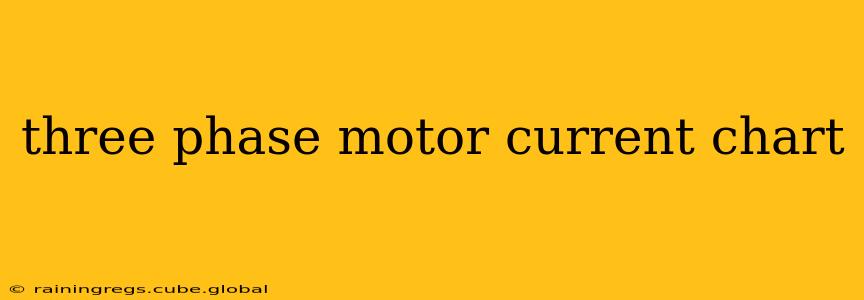Three-phase motors are workhorses in industrial and commercial applications, powering everything from conveyor belts to HVAC systems. Understanding the current draw of these motors is crucial for efficient operation, preventative maintenance, and troubleshooting. This guide will explore three-phase motor current charts, explaining what they show, how to interpret them, and why they're essential for motor management.
What is a Three-Phase Motor Current Chart?
A three-phase motor current chart is a visual representation of the motor's current consumption under various operating conditions. It typically plots current (measured in amps) against another variable, often load (expressed as a percentage of full load or horsepower). These charts can be provided by the motor manufacturer or generated through motor testing. They're invaluable tools for:
- Predictive Maintenance: Identifying trends in current draw can help predict potential motor failures before they occur. A consistent increase in current, for instance, could signal bearing wear or winding degradation.
- Troubleshooting: Comparing the actual motor current to the chart's values can pinpoint problems like imbalances in the power supply or mechanical issues within the motor itself.
- Energy Efficiency: Analyzing current draw at different loads allows for optimization of motor operation and identification of potential energy savings.
- Motor Sizing: Charts help determine if a motor is appropriately sized for the intended application. Consistent operation near the maximum current rating could indicate the need for a larger motor.
What Information Does a Three-Phase Motor Current Chart Show?
A typical chart will display:
- Current (Amps): This is usually the vertical axis, showing the amount of current drawn by the motor.
- Load (Percentage of Full Load or Horsepower): This is generally the horizontal axis, indicating the motor's operational load. It might be expressed as a percentage of the motor's rated full-load current or as horsepower.
- Full-Load Current (FLC): This is the current drawn by the motor when operating at its rated horsepower or full load. It's a key parameter specified by the manufacturer.
- No-Load Current: This is the current drawn when the motor is running but not under any significant load. It represents the motor's internal losses.
How to Interpret a Three-Phase Motor Current Chart
Interpreting a three-phase motor current chart involves comparing the measured current of your motor to the values on the chart at a given load. If the measured current significantly deviates from the expected value, it suggests a potential problem. For example:
- Higher than Expected Current: This could indicate an overload, mechanical friction, a failing bearing, or an issue within the motor windings.
- Lower than Expected Current: This could indicate a reduced load, a problem with the power supply, or even a partially failed motor.
Remember, variations in ambient temperature and supply voltage can slightly affect current draw. It's important to consider these factors when analyzing the chart.
What factors influence the current of a three-phase motor?
Several factors significantly impact the current drawn by a three-phase motor. Understanding these factors is critical for accurate interpretation of current charts.
Load: The most significant influence on motor current is the mechanical load. A higher load demands more power and therefore higher current.
Voltage: Variations in supply voltage directly affect the motor's current draw. Lower voltage often leads to higher current to produce the same power.
Power Factor: The power factor indicates how efficiently the motor uses the power supplied. A lower power factor results in higher current for the same output power.
Frequency: Changes in supply frequency can alter the motor's performance and influence current draw, though this is less common than voltage or load variations.
Temperature: Higher ambient temperatures can increase the motor's resistance, leading to a slightly higher current draw for the same load.
Motor Condition: Worn bearings, faulty windings, or other internal problems can lead to increased current draw. This is a critical point to consider when using current charts for predictive maintenance.
How to Use a Three-Phase Motor Current Chart for Troubleshooting
If your motor's current draw differs significantly from the chart's expected values, here's a systematic troubleshooting approach:
- Verify the Load: Ensure the motor is operating under the expected load. Measure the actual load to confirm it matches the chart's load parameters.
- Check Voltage and Frequency: Use a multimeter to measure the supply voltage and frequency to ensure they are within the motor's specifications.
- Inspect the Motor: Look for obvious signs of damage, such as loose connections, overheating, or unusual noises.
- Check for Imbalances: Measure the current in each of the three phases. Significant differences suggest an imbalance in the power supply or within the motor itself.
- Consider Environmental Factors: Account for the impact of ambient temperature on current draw.
By carefully analyzing your three-phase motor current chart in conjunction with a systematic troubleshooting process, you can significantly improve the efficiency, reliability, and longevity of your motor systems. Remember that consistency in monitoring current draw and proactive maintenance are vital components of successful industrial motor management.
